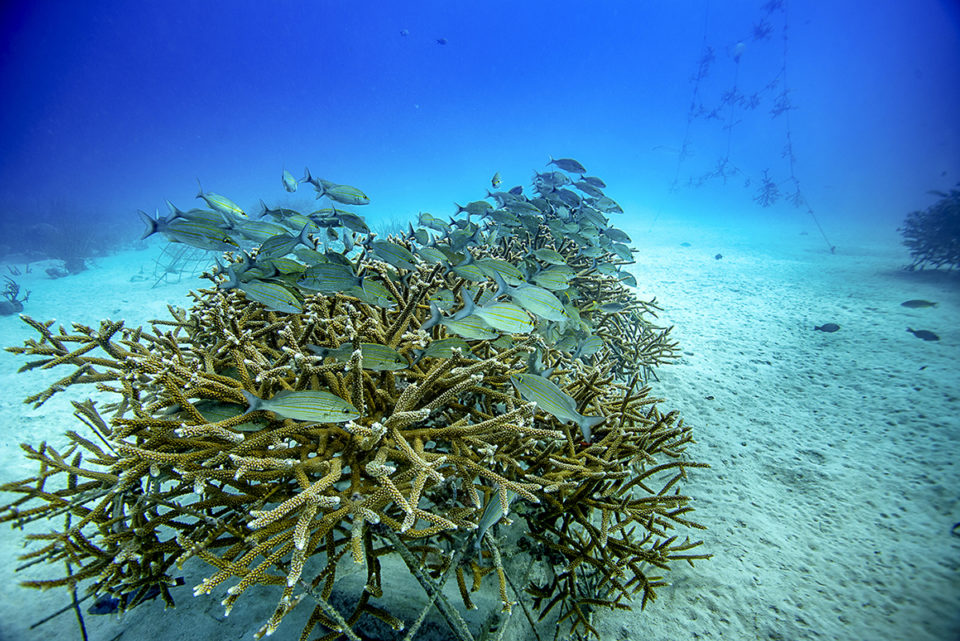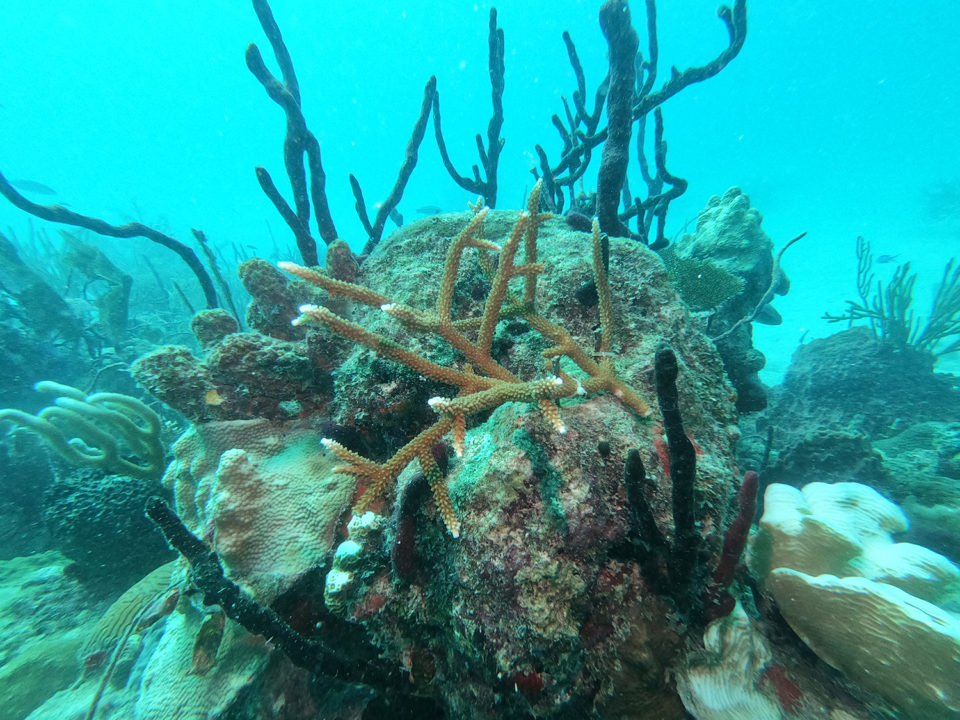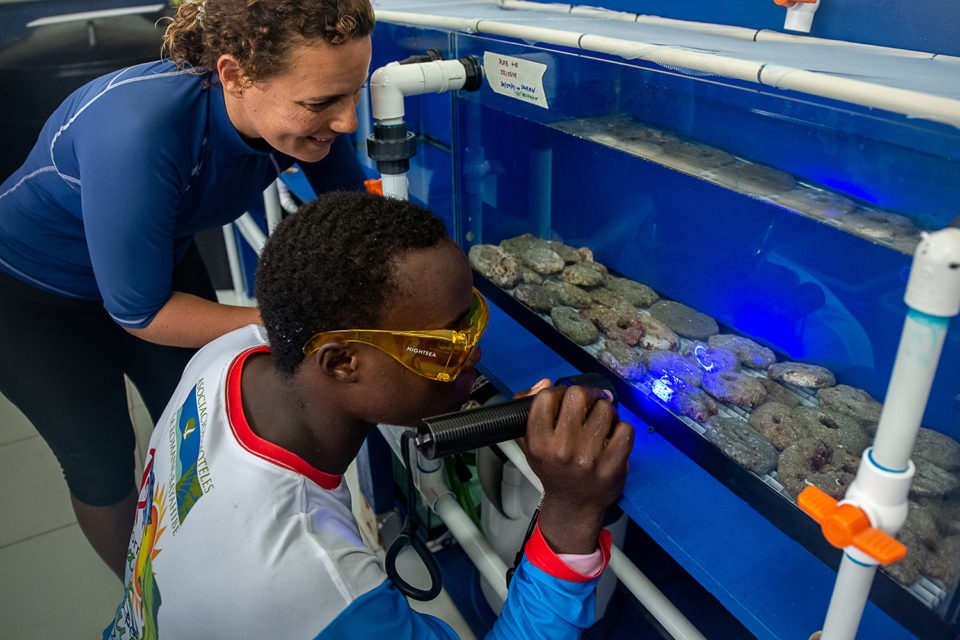Aquaculture plays different roles in coral culture

Coral reefs are not just spectacularly beautiful underwater ecosystems – they also play an outsized role in supporting ocean health and economies. Covering less than 1 percent of the sea floor, coral reefs are critical habitat for an estimated 25 percent of all marine species. As a result, fisheries benefit directly from coral reefs, which makes the conservation of reefs a sensible economic proposition as well as a wise decision for planetary health.
Conservation aquaculture often plays a supportive role in fisheries improvement. Overfished or otherwise stressed species can be revived through stock enhancement, perhaps combined with restoration of fish habitat, such as oyster beds. This type of intersection between aquaculture and fisheries is one example of how the two sectors are bonded in positive ways. It is this outlook that is guiding the evolution of the Global Aquaculture Alliance to the Global Seafood Alliance in 2021, as announced by its CEO, Wally Stevens, at the GOAL conference in October. In tandem, the emerging Center for Responsible Seafood will dive deeper into ocean health issues, formally embracing an ecosystem approach to aquaculture and fisheries.
Globally, more than half a billion people depend on coral reefs for food, income, coastal protection and more. As an integral piece of Sustainable Development Goal 14, Life Below Water, the urgent need to protect and restore the biodiversity of coral reefs has fueled an increasing number of projects, research studies and investments.
Coral culture
Aquaculture plays different roles in coral culture depending on the approach to reef restoration. Corals can reproduce both sexually (by spawning) and asexually (by cloning polyps and expanding or beginning new colonies). Reef restoration scientists and managers are working with both approaches and assessing their potentials for large-scale success. Where the resources are available, restoration projects are incorporating both sexual and asexual reproduction.
Genetic diversity is the key to giving corals the best chance for adaptation and survival. Extreme temperature events caused by climate change are a significant factor contributing to the global decline of coral reefs, so restoration approaches must include interventions to promote climate resilience. Some corals are genetically adapting to warmer waters, and restoration techniques may play a role in speeding up natural adaptations while we simultaneously strive to mitigate impacts from global warming, pollution, and overfishing.
SECORE International is an organization with a mission to create and share the tools and technologies to sustainably restore coral reefs worldwide. Their partners are numerous and include The Nature Conservancy (TNC), the Australian Institute of Marine Science, Newcastle University in England, and many Caribbean partners. SECORE is also a partner in one of the largest investments in reef restoration in the world – the effort to restore seven iconic reefs in the Florida Keys. This partnership is led by the National Oceanic and Atmospheric Administration (NOAA) and includes TNC, Coral Restoration Foundation, the National Marine Sanctuary Foundation, Reef Renewal, and other organizations and academic institutions.
SECORE is focused on the sexual reproduction of corals because the ability to capture just some of the gametes during a coral spawning event can lead to growing millions of coral babies, each one being genetically unique. After gametes are captured during a coral spawning event and fertilized in the lab, the coral larvae then settle on a uniquely designed substrate, and coral polyps start to grow several days later. That piece of substrate with coral polyps growing on it is then outplanted on a reef.

Working with the asexual reproduction of corals involves coral culture in underwater nurseries. The nurseries can be established in various ways. Sometimes the coral fragments are a collection of pieces that broke from reefs during severe storms. If coral has been grown in a lab, then cultured fragments can be used to start a nursery. If a nursery in another area is growing prolifically, then fragments can be transplanted to a new nursery.
As with all other forms of aquaculture, the design of structures and methods is continually evolving with innovative ideas. There are two main types of nursery structures: floating and fixed to the bottom. They can be found in the shape of trees, arches or tables, among others, and the diversity of designs is influenced by factors such as site characteristics, environmental conditions, permitting regulations and available resources.
A community growing reefs and conservationist fishers
One of SECORE’s Caribbean partners, Fundación Dominicana de Estudios Marinos (FUNDEMAR), located in Bayahibe, Dominican Republic, exemplifies the uplifting story of how a restoration project can grow when it has the essential combination of grassroots determination and wider partnerships.
In 2005, as a young fisherman still in school, Alido Luis Baez volunteered when he was asked to help Rita Sellares, director of FUNDEMAR, with a project to eliminate the illegal capture of dolphins in the area. Alido had been fishing with his father since he was 8 years old, and he began fishing on his own at the age of 14. He knew the places where dolphins were often sighted. This conservation project was the beginning of Alido’s role with FUNDEMAR, which led to him becoming a founding co-creator of the existing programs.
When funds were available, Alido was hired on various projects as a staff member, but when funds dried up, Alido’s commitment to working with Rita continued. They sometimes used his father’s fishing yawl, and “little by little, with a lot of work, we managed to get to what FUNDEMAR is today,” Alido told the Advocate.
FUNDEMAR’s first Acropora cervicornis (staghorn coral) nursery was established in 2011 with approximately 150 cm of coral tissue, and at that point, there was no formal monitoring of the health of the existing reefs. Monitoring stations were established, the restoration program got underway, and an impressive 5.5 km of coral tissue has been outplanted to the reefs. Eight nurseries hold an additional 3 km of coral tissue for reef restoration.

Inspired by a guest scientist who visited several years ago, Rita decided that it was time to upscale FUNDEMAR’s sexual reproduction of corals. After she and her team attended coral reproduction and restoration workshops in Curaçao and Mexico, FUNDEMAR officially joined SECORE’s network as a partner in August 2018. This partnership made it possible for FUNDEMAR to establish a lab and acquire other equipment to grow their program. Since 2019, more than 5,100 substrates hosting baby corals (individual coral polyps) have been put in place for reef recovery. This translates to roughly 259,000 outplanted baby corals, with the majority of them outplanted this year, despite the challenges presented by COVID-19.
Monitoring and evaluation is taking place to assess success and to innovate with both the asexual and sexual reproduction, planting and growth of corals. While high survival rates of restored corals are obviously important, another key metric is the observation of restored corals spawning in the wild. This exciting milestone has been observed both in the nurseries and with the nursery-grown, outplanted Acropora cervicornis on FUNDEMAR’s restored reefs. The same thrilling occurrence was observed for the first time in August 2020 in waters off Miami. It is a critical indication that the restored corals can naturally replenish reefs and add new genetic diversity, which increases resilience to climate change, disease and other stressors.
The other impressive growth story is in the community support for FUNDEMAR’s work. Just as the interdependent and complementary functions of reef inhabitants create a cohesive ecosystem, the local community has created an organic, well-functioning structure that supports FUNDEMAR’s work – a recognition that they must protect the reefs that support their way of life and livelihoods.

After the first hotel signed on as a partner in 2011, providing financial and other resources in support of reef restoration and nursery maintenance, it was not long before formal contracts were signed with most of the hotels and dive centers in the area. Others provide informal support. A modest amount of government funding now comes to FUNDEMAR also.
One of FUNDEMAR’s partner hotels, Iberostar Hotels & Resorts, has the resources to maintain its own lab and genetic bank of corals as part of its Wave of Change program, which also promotes sustainable seafood and the elimination of single-use plastics. The Iberostar’s dive center, Dressel Divers, contributes boats, captains and divemasters to reef restoration activities. Another partner dive center, Slow Dive, teaches teenage boys – future fishermen – how to dive and monitor reef health by recording benthic and coral composition, along with fish diversity. To see FUNDEMAR and their partners in action is to see a community decisively taking responsibility for all components of ecosystem stewardship – conservation, science and education.
As both a fisherman and a member of the conservation community, Alido shares his perspective on healthy reefs with other fishers: “I talk to them about how continuing to fish irresponsibly will have negative consequences in their future. I try to make them understand that protecting the reef and not catching small fishes will allow them to continue fishing in the future. It is difficult with the older fishermen since fishing is their only livelihood, and they try to make the most of it even if it means breaking the laws. My hope is in the young boys who are growing up now, especially those who are being trained by FUNDEMAR. Our duty is to teach them to follow good fishing practices.”
In the communities both above and below the waves, each component has its function in working toward the common goal of a healthy ocean. Conservation aquaculture and responsible fisheries can be proud of their supporting roles, but the starring role is played by healthy coral reefs.
This holiday season (and year round), a contribution to FUNDEMAR’s reef restoration work is an investment in a healthy ocean and healthy fisheries.
Now that you've finished reading the article ...
… we hope you’ll consider supporting our mission to document the evolution of the global aquaculture industry and share our vast network of contributors’ expansive knowledge every week.
By becoming a Global Seafood Alliance member, you’re ensuring that all of the pre-competitive work we do through member benefits, resources and events can continue. Individual membership costs just $50 a year. GSA individual and corporate members receive complimentary access to a series of GOAL virtual events beginning in April. Join now.
Not a GSA member? Join us.
Author
-

Laura Rose
Laura Rose is an independent consultant with a background in marine conservation, aquaculture, and international development. She is based in Washington, D.C. Follow her on Twitter @fish4good.
Tagged With
Related Posts

Responsibility
A wider view: At GOAL, focus steers to fisheries, food systems and the future
During the virtual event, researchers discussed the importance of aquatic foods, which billions worldwide rely on for protein and micronutrients.

Responsibility
A wider view: Consensus on seafood’s planetary and human health benefits
Several recent reports echo the message that eating sustainable seafood can help save the planet while making significant gains in public health.

Responsibility
A wider view: It’s blue food’s time
There is urgency to conversations about the role of blue food in mitigating climate change, increasing momentum toward some specific goals.

Responsibility
Can nutrition-sensitive aquaculture futureproof fish farming?
Research finds that nutrition-sensitive aquaculture can benefit public health through diverse, nutrient-rich seafood, and enabling equitable access to it.

